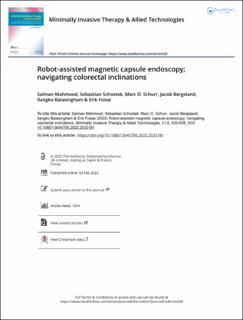| dc.contributor.author | Mahmood, Salman | |
| dc.contributor.author | Schostek, Sebastian | |
| dc.contributor.author | Schurr, Marc O. | |
| dc.contributor.author | Bergsland, Jacob | |
| dc.contributor.author | Balasingham, Ilangko | |
| dc.contributor.author | Fosse, Erik | |
| dc.date.accessioned | 2023-03-20T10:25:50Z | |
| dc.date.available | 2023-03-20T10:25:50Z | |
| dc.date.created | 2022-04-27T11:14:51Z | |
| dc.date.issued | 2022 | |
| dc.identifier.citation | MITAT. Minimally invasive therapy & allied technologies. 2022, . | en_US |
| dc.identifier.issn | 1364-5706 | |
| dc.identifier.uri | https://hdl.handle.net/11250/3059196 | |
| dc.description.abstract | Purpose: To investigate the interaction of a robot assisted magnetically driven wireless capsule endoscope (WCE) with colonic tissue, as it traverses the colorectal bends in the dorsal and ventral directions, relying only on the feedback from a 3D accelerometer. We also investigate the impact of shell geometry and water insufflation on WCE locomotion. Methods: A 3D printed incline phantom, lined with porcine colon, was used as the experimental platform, for controlled and repeatable results. The tilt angle of WCE was controlled to observe its influence on WCE locomotion. The phantom was placed underwater to observe the effects of water insufflation. The experiments were repeated using the two capsule shell geometries to observe the effect of shell geometry on WCE locomotion. Results: Friction between WCE and intestinal tissue increased when the tilt angle of the WCE was lower than the angle of the incline of the phantom. Increasing the WCE tilt angle to match the angle of the incline reduced this friction. Water insufflation and elliptical capsule shell geometry reduced the friction further. Conclusion: Tilting of the WCE equal to, or more than the angle of the incline improved the WCE locomotion. WCE locomotion was also improved by using elliptical capsule shell geometry and water insufflation. Abbreviations: CRC: colorectal cancer; GI: gastrointestinal; MRI: magnetic resonance imaging; WCE: wireless capsule endoscope | en_US |
| dc.description.abstract | Robot-assisted magnetic capsule endoscopy; navigating colorectal inclinations | en_US |
| dc.language.iso | eng | en_US |
| dc.publisher | Informa UK Limited | en_US |
| dc.rights | Attribution-NonCommercial-NoDerivatives 4.0 Internasjonal | * |
| dc.rights.uri | http://creativecommons.org/licenses/by-nc-nd/4.0/deed.no | * |
| dc.title | Robot-assisted magnetic capsule endoscopy; navigating colorectal inclinations | en_US |
| dc.title.alternative | Robot-assisted magnetic capsule endoscopy; navigating colorectal inclinations | en_US |
| dc.type | Peer reviewed | en_US |
| dc.type | Journal article | en_US |
| dc.description.version | publishedVersion | en_US |
| dc.source.volume | 31 | en_US |
| dc.source.journal | MITAT. Minimally invasive therapy & allied technologies | en_US |
| dc.source.issue | 6 | en_US |
| dc.identifier.doi | 10.1080/13645706.2022.2032181 | |
| dc.identifier.cristin | 2019417 | |
| cristin.ispublished | true | |
| cristin.fulltext | original | |
| cristin.qualitycode | 1 | |

